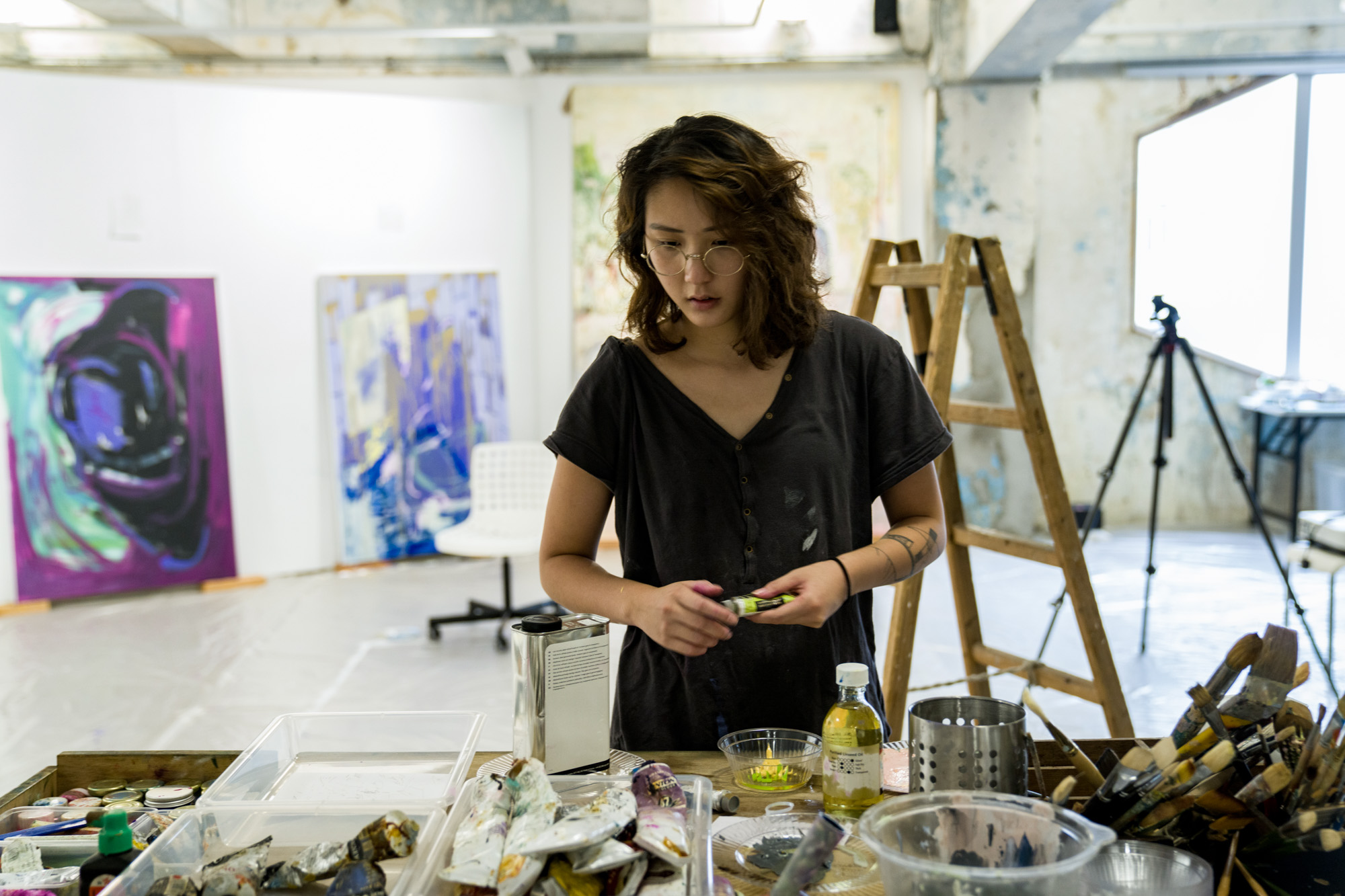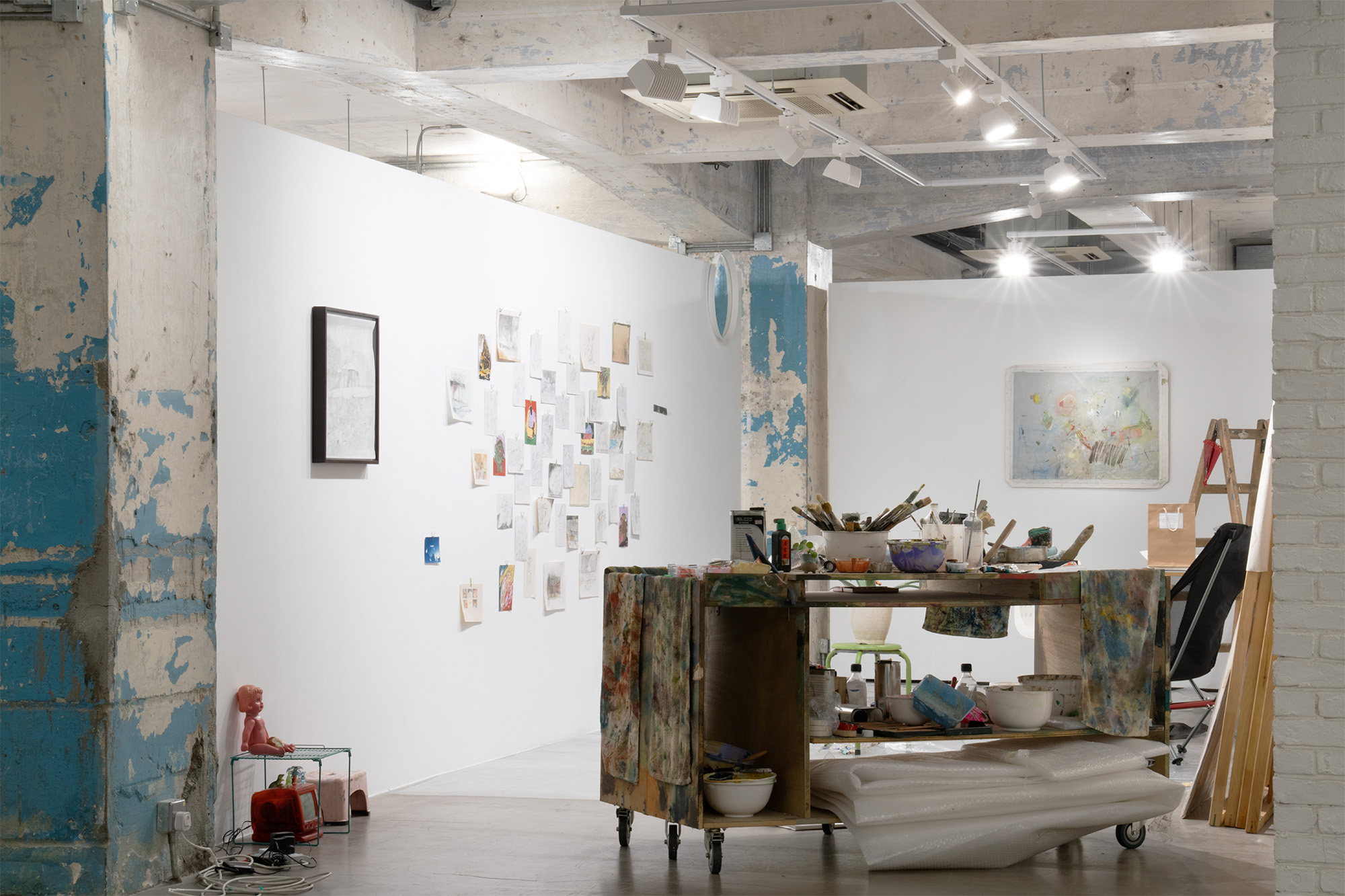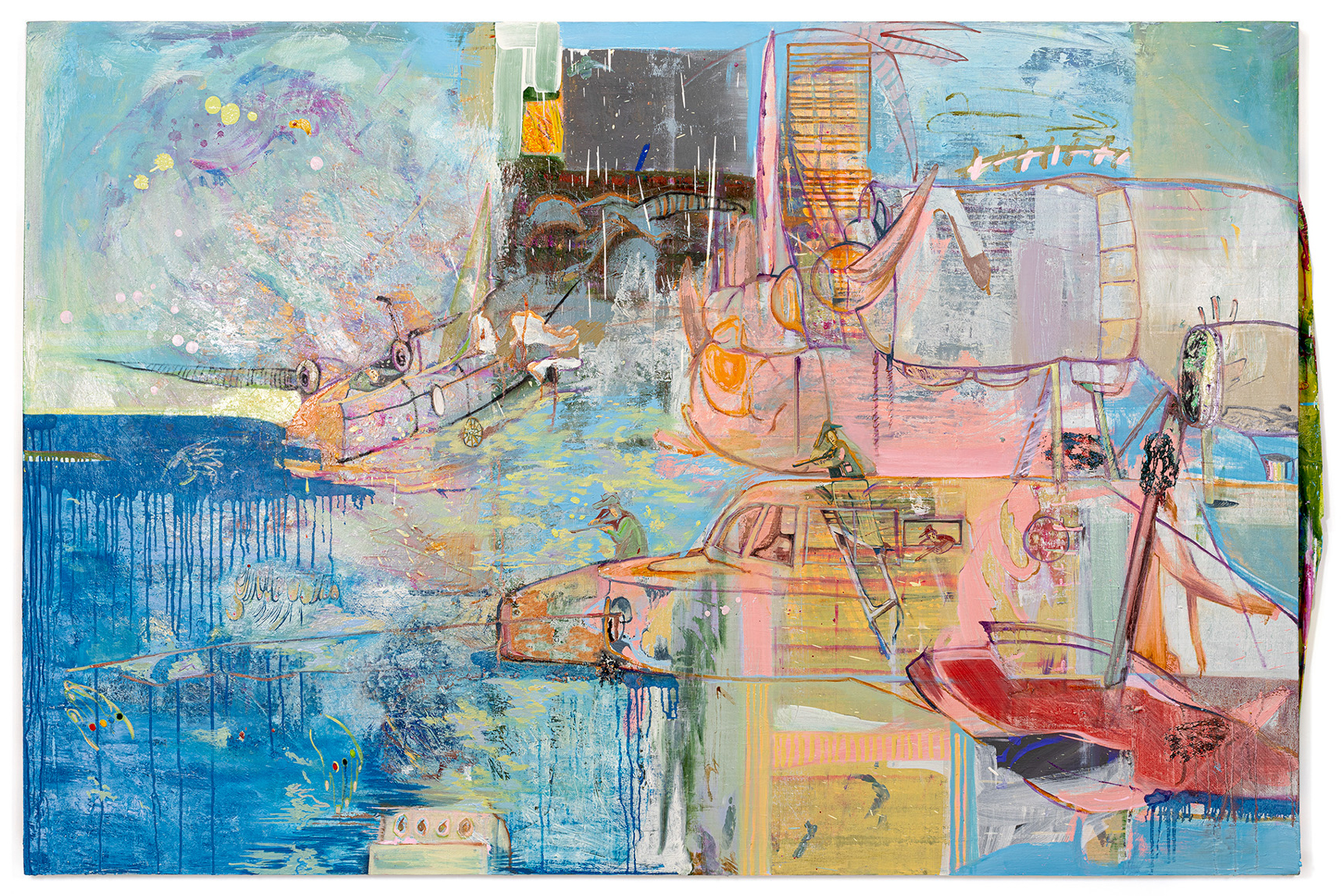People
For Now: Interview with Un Cheng


When I met Un Cheng at Hong Kong’s Blindspot Gallery in late September, she was in the middle of installing her presentation “In the name of moon, I’ll punish you,” which features the paintings that she created during her June–September residency at the gallery alongside a selection of her earlier works. Densely layered with brusque brushstrokes, paint splatters, fluid lines, and diffuse patches of pastel hues, these canvases are populated by slumping, huddled bodies, and stem from the artist’s experiences of Hong Kong’s pro-democracy movement. I spoke to Cheng about the physical and emotional tolls of political demonstrations, the gendered division of labor at protests, and the way she composes her images.
“In the name of moon, I’ll punish you” is a catchphrase from the Japanese anime and manga series Sailor Moon. Why did you choose this line as the title of your show?
Each painting in this new collection has a story that relates to my life during the pro-democracy movement in Hong Kong, including depression and the other health issues that I experienced. While painting and recalling the past year, I began to reflect on the hero complex. I grew wary of heroism. In Sailor Moon, the heroines declare to their enemies: “In the name of moon, I’ll punish you!” The word “punishment” is negative—we typically understand it to mean vengeance for an evil deed or sin. To punish someone, we take something away from them. In that sense, “punishment” is different to “redemption,” which implies an action that is restorative, compensative, and positive in effect. Punishment is a romantic fantasy—it’s what we do when redemption is impossible and there’s no way to properly remediate a conflict. The line from Sailor Moon evokes an unresolved state and an intermediary gesture, which is fitting for the showcase because it is the result of a residency, not a formal exhibition, and my works reflect my emotional responses to a situation that is not yet settled.
Were there any specific instances that led you to be disillusioned about heroism?
The entire second half of 2019 and early this year. From what I observed, the movement’s participants thought of themselves as having the hearts of warriors. But where does that idea come from? It’s influenced by heroism. When you’ve tried for a long time but still fail, you start to just hope for a hero to come along. People tried to be their own heroes but it seemed like there are things that one simply cannot achieve, though there’s no saying what will happen in the future.
Canvases such as Beer, Weed and Spinach and Setting a trap for you (all works 2020) depict figures sitting on toilets. Are these about the physical impacts of the demonstrations?
Yes. Those six months in 2019 made me fall into a depression. Stress accumulated to a point where I felt like I was going to explode. There was one night when I went drinking, and the day before I had eaten a lot of spinach. I ended up vomiting badly. I was curled up like a baby and blacked out. When I woke up, my face was white and my lips were purple. That moment was really upsetting. After that night, I realized that I could not go on like that. During a time that was already physically and emotionally draining, I was doing things that were so stupid.
In another painting, I contemplate sex. It’s the one with someone standing on a skateboard that looks like it’s going to explode [Memory stretches as long as a rail]. I lost all of my desires during that time. Sex is primal, so to stop wanting that is like having one’s connection to one’s own body severed.
On the other hand, Teenage girls with bricks speaks to the gender dynamics of the protests. The men usually tell the women to back down from the front lines—it comes from a place of care, but it’s confusing to say the least—so the women end up gathering elsewhere, and the operations become very much gendered. One day, I saw a group of adolescent girls digging up bricks from the sidewalk—not an unusual task for female protesters. I was studying what they were doing and thinking about what I could do as a woman.
It’s been a while and now I’m looking back at these events as memories. I didn’t want to include my political opinions in my paintings—that’s not what I want to express. I tried really hard to separate my art practice from politics. I just wanted to reflect my personal experiences. I’m not trying to tell people how badly the unrest has impacted my life either. The paintings are insignificant in the grand scheme of things. But my process has always entailed paying attention to what happens in Hong Kong. When society is changing dramatically, you can’t escape that.

I saw some drawings on your desk in the gallery. Do you usually sketch your compositions before painting?
No. I go straight to the canvas. At most I would do a bit of sketching while painting simultaneously. I like to be spontaneous so my work isn’t rigid. But because I hadn’t painted in half a year and I was about to give up—I didn’t have a studio, job, or money—I did some drawings just to keep creating art.
In these latest drawings, there are people. In the past, I mainly painted landscapes. When you’re rendering people, it doesn’t matter how you depict them, there’s this element of storytelling, and you’re always projecting your own perspectives and character onto the piece. The thinking process is very different from the process for the landscapes that I used to create. So it’s all experimentation. I don’t think I’ve totally grasped incorporating humans in my paintings. They appear like people, but they’re not people . . .
The figures are almost hidden under layers of abstraction. Why did you express them in that way?
I think it’s precisely because I don’t view them as people. Artists like Francis Bacon or Lucian Freud were very aware that they were painting a person. They connected with the subject on the canvas, or it was a self-portrait. They inspected the person, the textures, the mood. But when I paint figures, I’m using the same mindset from when I paint landscapes: I view the people as scenes.
I tend to focus on the visual harmony and balance of my paintings. The elements in my compositions all respond to one another. There’s a reason behind every mark and gesture. It’s all logical. But people are really complex. I wasn’t trying to capture the subject’s emotions and thoughts. I don’t know those people, it’s not my business. I was just painting the scene and, in that process, I created an image of my world. So maybe that’s why viewers think my works are abstract and almost cold-blooded. I really don’t depict people.

Why did you choose a palette of soft pastels?
I was already using these colors in university. My professor thought it was sweet. I’ve heard a few viewers say they thought my paintings were by a male artist, but then they would wonder why a man would use such “sissy” colors. I’m playing with those expectations. My thoughts and the subjects of my paintings are quite dark, so I like to give the compositions fairy-tale qualities.
The colors are also connected to where I live. Housing estates in Hong Kong typically have soft hues that are different from what you’d see in Central or Sheung Wan. I’m an estate girl. The colors reflect life at society’s grass roots. They also tie into what I see when I look out my window: the ocean, boats, and ship factories.
Searching for hand hand has something that looks like an airplane, but it also resembles a boat . . . which is it?
I have a book about the history of airplanes, and there is an old seaplane in it. So that’s what it is. Searching for hand hand is about an incident that I witnessed in Tsim Sha Tsui. There were a lot of police boats in the harbor. I grew up watching ships sail by so I was wondering why I hadn’t seen a police boat before. My first reaction was to go and see what they were. Then, more police arrived. Apparently, a couple had seen what they thought was a hand floating in the harbor. They followed it along the coast for half an hour and then decided to call the police. The police came but they couldn’t find the hand. The officers asked the witnesses a lot of questions: Maybe they had made a mistake? Had they been drinking or were they feeling unwell? Maybe it wasn’t a hand? Why would it float upright like that?
The moment struck me because with the current situation in Hong Kong, when you see a scene like that, the first thought that comes to mind is that someone else has mysteriously died without explanation. It’s imaginable, even if the questions that the officers were asking made sense. This kind of suspicion is now common in Hong Kong.
What are your plans for the future?
I haven’t thought about it too much; I just want to learn more. Painters need space and time. Life experiences are important.
Un Cheng's “In the name of moon, I’ll punish you” was on view at Blindspot Gallery, Hong Kong, from October 6–24.







